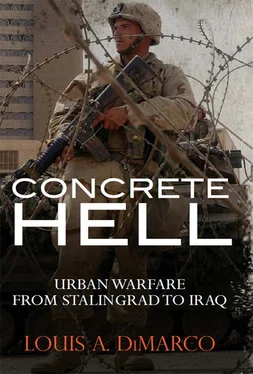The other type of missions conducted by special forces as part of the urban battle were much more specialized, and generally limited to the elite national-level special forces units. These types of missions could include assaults to capture or kill major militant leaders, or to rescue hostages. Israeli special forces also conducted covert missions. In these missions they drove specially outfitted civilian cars, wore civilian clothes, and blended in with the Palestinian civilian population. Usually, but not always, in this covert role the missions were limited to reconnaissance and information gathering.
Two other important units employed as part of the Jenin operation were army engineers equipped with Caterpillar-built D9 armored bulldozers, and Merkava tanks of the armored corps. These heavy armored elements were employed in a manner similar to their use in Nablus. The D9R dozer made by the US Caterpillar Corporation was not a purpose-built military vehicle but rather a very powerful civilian construction bulldozer. The vehicle was 13 feet tall, and 14.7 feet wide with its standard blade; it weighed 54 tons, and was powered by a 405hp engine. The D9’s first major military use was during the Vietnam War when the US Army used them to clear jungle. The Israeli military added massive armored plating to the machines to give them the capability to work while under fire. Israeli soldiers nicknamed the giant bulldozers “doobi,” which translates to “teddy bear.” Its armor protection could deflect all small-arms fire and even rocket-propelled grenades. There are reports that D9R dozers survived improvised explosive device (IED) attacks by bombs weighing as much as 440lb and 1,100lb. The initial advance into the refugee camp began with an armored bulldozer clearing the three-quarter mile approach to the camp. During that operation an engineer officer noted that the dozer set off over 120 IEDs without sustaining significant damage.
The 5th Brigade entered the camp dismounted. The Palestinian militants were surprised, and pleased, that the Israelis did not lead with armored vehicles. The decision to begin the attack on foot was to minimize civilian casualties. For three days the Israeli infantry slowly and methodically advanced. Their movement was greatly hampered by the extensive mining that the Palestinians did on all approaches into the camp. Militant fighters reported that they deployed 1,000–2,000 IEDs. Some were large antivehicle devices but most were small, about the size of a water bottle, designed to kill infantry. The militants’ objective was to inflict as many casualties as possible on the IDF, and their main method of doing that was by setting up booby-traps throughout the camps. In particular the Palestinians booby-trapped the major alleyways, doors and windows to houses, cars, and the interior of houses. Inside houses IEDs were placed in doorways, cabinets, closets, under and inside furniture. They concentrated their booby-traps in abandoned houses, or in the homes of prominent militants that they were sure the Israelis would search. In the first three days of the battle little progress was made into the camp, seven IDF soldiers were killed, and in some cases units only advanced at a rate of 50 yards a day.
The IDF estimated that the Jenin operation would take 48–72 hours to complete. By April 6 they were four days into the operation, units were still only advancing very slowly against very stiff opposition, and casualty rates were much higher than expected. Israeli army headquarters began to put pressure on the division commander to pick up the pace of operations. The IDF had a long history of rapid, decisive operations. Speed was a highly valued quality because with it came surprise and the shock effect. The IDF was also concerned with speed for strategic reasons. The history of the wars between Israel and its Arab neighbors indicated that in any major military operation, especially if it was successful, international and United States diplomatic pressure would be put on the Israeli government to end the operation. This pressure would steadily mount until invariably the Israeli prime minister halted the operations. Thus, the Israeli senior commanders understood that the IDF had an unknown but finite amount of time to clear and seize Jenin. If that did not occur before the diplomats halted operations then the operation would fail.
While the 5th Brigade slowly moved ahead, in the southwest Battalion 51 was making better progress. This difference was because the Battalion 51 commander determined to use the same tactics that the Golani Brigade had used in Nablus: leading with D9 dozers, then mechanized infantry in their carriers, and finally, tanks firing in support. However, the slow progress of the 5th Brigade allowed the Palestinians to focus on Battalion 51, and thus, despite the battalion’s aggressive tactics, it was fighting fiercely for every building. On April 8, as fighting ended in Nablus, the Golani Brigade commander, Colonel Moshe Tamir, visited and assessed the situation in Jenin. He recommended that more aggressive tactics, similar to those of Battalion 51, be adopted. Division headquarters continued to emphasize speed to the commanders in Jenin, and set the next day, April 9, as the date the mission had to be completed.
Early on the morning of April 9, a 5th Brigade Infantry Company from Reserve Battalion 7020 moved forward to occupy a building to serve as the base for the day’s operations. As they moved forward, wearing their night-vision devices in the early morning darkness, they diverted from their planned route. As they moved down a 3ft-wide alley between buildings they were suddenly attacked by bombs thrown at them, and small-arms fire. Within seconds, a half dozen soldiers were hit and down, including the company commander. The ambushed element of the 5th Brigade found itself cut off, surrounded, and under intense fire from militant gunmen shooting from upper-story windows. All but three men in the unit were killed or wounded as they sought cover in a small open courtyard. An initial effort to rescue the element inadvertently stumbled into a booby-trapped room and set off an IED that killed two more men and wounded several others.
Unmanned aerial reconnaissance loitered over the firefight and sent real-time images of the plight of the troops to IDF headquarters but the close range of the engagement — the combatants were within 30 feet — prevented the Israeli command from supporting their troops with heavy weapons. In the midst of the fight the Palestinians dashed forward and dragged off the bodies of three Israeli soldiers killed in the fight, with the intent of using the bodies as a negotiating lever at a later date. After several hours of frustrating combat, Shayetet 13 entered the battle and counterattacked to retrieve the bodies. The naval commandos quickly overran the Palestinian militants, retrieved the bodies of the fallen soldiers, and relieved the surrounded force. In total, 13 Israeli soldiers were killed and many more were wounded. It was the largest loss of life in a single day for the IDF in 20 years.
The ambush of April 9 consumed the energy of the Israeli command on that day, and put it further behind its timetable for securing the camp. It also demonstrated that careful, dismounted work in the tight confines of the camp could lead to unacceptable casualties. Thus, when the command renewed the attack the next day the 5th Brigade adopted a much more aggressive approach. On April 10 the Israeli attack was led by D9 bulldozers, followed by infantry mounted in the heavily armored Achzarit personnel carriers. Tanks and attack helicopters fired into buildings ahead of the dozers and infantry to force militants out. The dozers were extremely effective and literally buried any militants who tried to stay and fight in the rubble of their building. Several civilians who were unable to evacuate the area also became victims of the relentless destructive power of the armored bulldozers. When the Israelis estimated that they had arrived at the center of the Palestinian defensive network, they unleashed the full capabilities of the dozers which, under the covering fire of infantry and tanks, systematically eradicated a 200m by 200m (650ft by 650ft) square of two- and three-story buildings that formed the heart of the refugee camp. By the end of April 10 the central urban complex of the refugee camp, the center of the militants’ defensive scheme, was reduced to a flat, featureless open area devoid of any structures or cover. The Palestinian fighters had no choice but to retreat in front of the Israeli attack into the last remaining unoccupied neighborhood of the camp.
Читать дальше












